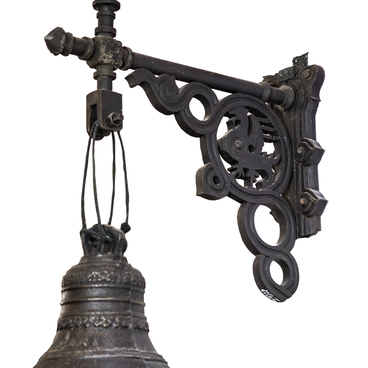Shackles are iron bracelets connected by a chain. They were put on the arms or legs of prisoners so that they could not move freely and escape. Sometimes shackled were used as a punishment. The chain for them was made of large links, but short enough that prisoners could not harm themselves or others with it. The bracelets were closed with a special metal rod that could not be removed by a prisoner himself. The chain could connect hand and leg shackles separately, or they could be a single system that constrained movement as much as possible. The shackles were sometimes nailed to the wall or the floor, or a load was attached to them, which would not allow the prisoner to move. One of the most popular punishments in the Russian Empire was being chained to a wheelbarrow that weighed about 80 kilos.
Shackles
Creation period
Late 18th – early 19th century
Dimensions
Handcuffs — total length: 42 cm, internal diameter: 7.5 cm. Foot irons — total length: 61 cm, internal diameter: 9 cm
Technique
Iron, forging
Collection
10
Open in app#1
Hand and feet shackles
#9
#10
The hand and foot shackles in the collection of the Nevyansk Historical and Architectural Museum were made in the late 18th–early 19th centuries at the Nevyansk Plant. Here they were widely used to pacify workers: the first plant owners more than once had to pacify riots and unrest among the workers. For this purpose, a variety of punishments were used: in addition to shackles, the culprit could be whipped with a whip or a stick, sent to a dungeon. For example, in 1742, the Nevyansk plant office tried to recover arrears of the head tax for the ‘retired’ workers.
#11
The workers refused, and unrest began in 10 of Demidov’s plants, which caused large losses and disruptions in the supply of goods, especially for the army. Ensign Klim Ivanov came to the Nevyansk plant to collect the arrears. He arrested and shackled some workers and “kept them until ordered.”
#12
The Nevyansk peasants assigned to the Nevyansk plant, outraged by the increase in work with a decrease in pay, also took part in the protests. The assigned peasants had to work only for the amount of the per capita tax, but it was decided “to use them in all kinds of work equally with serfs”. Also, the permanent workers assigned to Nevyansk and other factories “forever” were not serfs. The struggle of the permanent workers for their right to work only the per capita salary at the plant, and otherwise work “willingly, ” went on for several decades. This gave them the right to higher wages, as well as freedom to engage in trade and crafts.
#13
State Autonomous Cultural Institution of the Sverdlovsk Region "Nevyansk State Historical and Architectural Museum"
read morehide
00:00
00:00
1x
Shackles
Creation period
Late 18th – early 19th century
Dimensions
Handcuffs — total length: 42 cm, internal diameter: 7.5 cm. Foot irons — total length: 61 cm, internal diameter: 9 cm
Technique
Iron, forging
Collection
10
Open in app
Share

